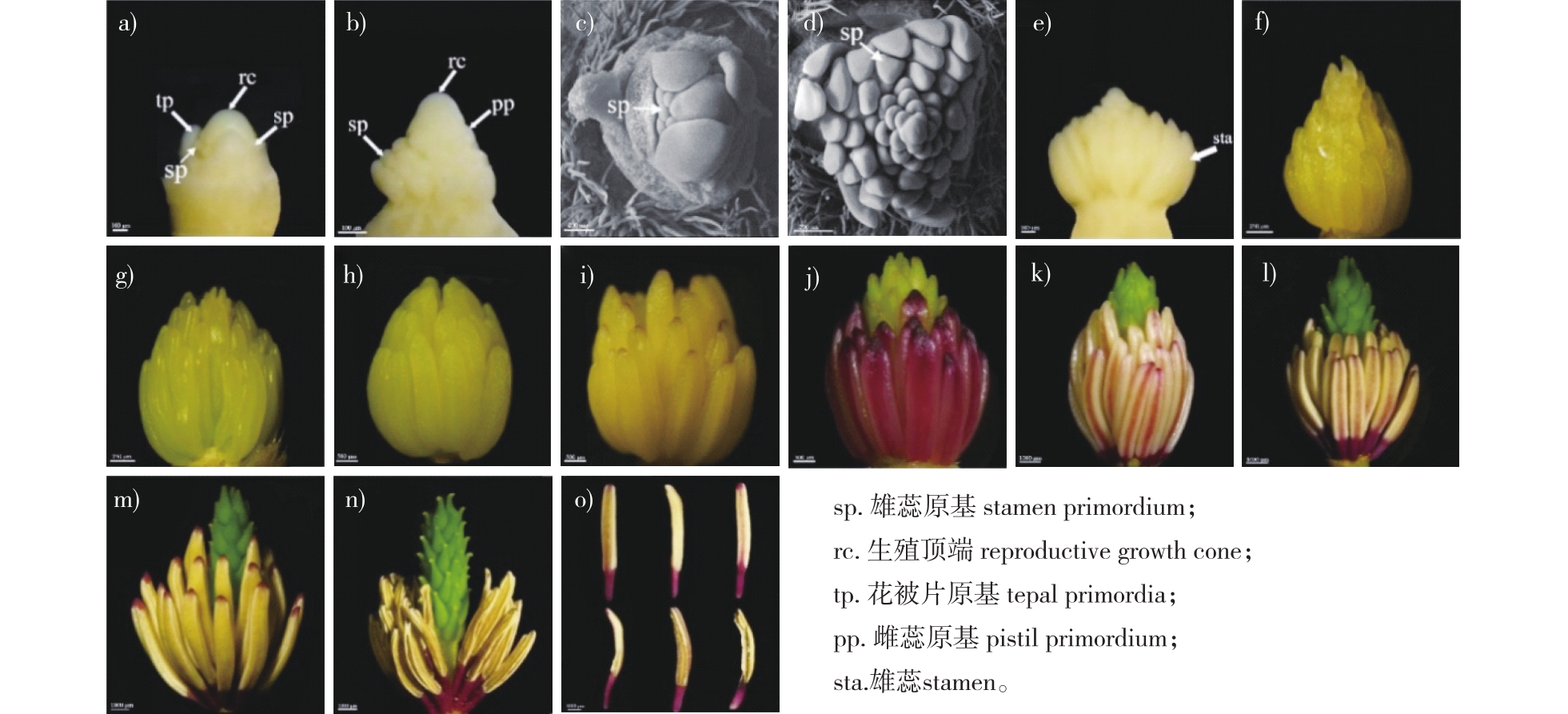 PDF(6586 KB)
PDF(6586 KB)


 PDF(6586 KB)
PDF(6586 KB)
 PDF(6586 KB)
PDF(6586 KB)
含笑花雄蕊发生与发育的基本特征
The basic characteristics of stamen morphogenesis and development in Michelia figo
【目的】观察含笑花(Michelia figo)雄蕊形态建成过程,探究其雄蕊发生和发育的基本特征,为木兰科植物繁育与进化生物学的研究积累基础资料。【方法】利用扫描电镜、显微成像及石蜡切片技术,对不同生长阶段含笑花花芽中的雄蕊进行解剖观察。【结果】含笑花雄蕊原基的发生方式为螺旋状排列、向心方式发生。随着雄蕊形态建成的完成,其表观形态特征发生系列变化,最终形成较长的花药与较短的花丝。花药组织包括花药隔和4个花药室。花药室内造孢组织分化形成的小孢子母细胞减数分裂不同步,最终形成左右对称型和正四面体型小孢子四分体,之后游离的小孢子发育成二细胞型花粉和少量的三细胞型花粉。花药壁由1层表皮细胞、1层药室内壁细胞、2~3层中层细胞及1层分泌绒毡层细胞组成。成熟花粉发育时期绒毡层解体消失,但部分中层细胞宿存,直至花药壁开裂时才完全解体消失。花丝外有1层表皮细胞包裹,内部由薄壁组织填充,中央贯穿着直达药隔的维管束。发育早期的花丝薄壁组织内具有气腔的结构,成熟期消失。【结论】含笑花雄蕊发生与发育的过程基本正常,雄蕊螺旋状向心发生、小孢子母细胞减数分裂不同步、花丝气腔结构的时序变化、多数左右对称型小孢子四分体及二细胞型花粉等基本特征,体现了木兰科植物的原始性。
【Objective】The fundamental characteristics of stamen morphogenesis and development were described according to the observation of stamen morphogenesis in Michelia figo. The findings provide valuable basic data for future investigations in plant breeding and evolutionary biology within the Magnoliaceae family.【Method】Using the scanning electron microscopy and paraffin section technology, the stamens of flower buds in M. figo at different growth stages were observed.【Result】The formation pattern of stamen primordium in M. figo was found to be helical and centripetal. Upon the completion of stamen morphogenesis, distinct morphological changes were observed, leading to the formation of a longer anther and a shorter filament. The anther tissue consists of anther septa and four anther locules. Normally, the sporogenous tissue differentiates gradually into microspore mother cells in the anther locule. The microspore mother cell meiosis was not synchronized, and eventually the isobilateral and tertrahedroid microspore tetrads were formed. Then, the free microspore developed into two-celled pollen and a few three-celled pollen. The structure of the anther wall was composed of one layer of epidermis cells, one layer of endothecium cells, two to three layers of middle layer cells, and one layer of secretory tapetum cells. During the development of mature pollen, the tapetum cells disintegrated and disappeared, but some middle layer cells persisted until the anther wall underwent dehiscence. The filaments were surrounded by a single layer of epidermis cells on the outer surface. Internally, the filaments were composed of parenchyma tissue, and a vascular bundle ran through the center toward the connective tissue. There was the cavity structure in the parenchyma of the filaments during the earlier development stage, which later disappeared during the mature stage of the stamen.【Conclusion】The process of stamen morphorgenesis in M. figo is normal compared with other Michelia plant species. The fundamental characteristics observed, including the helical centripetal formation of stamens, asynchronous meiotic division of microspore mother cells, temporal changes of the cavity structure in filaments, predominance of isobilateral tetrads, and two-celled pollen reflected the inherent nature of the Magnoliaceae family.

Michelia figo / stamen morphorgenesis / filament / anther / microspore tetrad
| [1] |
|
| [2] |
|
| [3] |
|
| [4] |
|
| [5] |
|
| [6] |
张风娟, 徐兴友, 陈凤敏, 等. 天女木兰小孢子发生及雄配子体发育的观察[J]. 经济林研究, 2008, 26(4):71-75.
|
| [7] |
陈丽园, 桑子阳, 陈发菊, 等. 红花玉兰大小孢子发生及雌雄配子体发育的研究[J]. 西北农林科技大学学报(自然科学版), 2016, 44(9):181-185.
|
| [8] |
王姗, 沈永宝, 鲍华鹏, 等. 宝华玉兰大小孢子发生和雌雄配子体发育过程中解剖结构的变化[J]. 植物资源与环境学报, 2021, 30(3):46-53.
|
| [9] |
潘丽琴, 郝建, 徐建民, 等. 灰木莲花药结构和花粉发育特征[J]. 林业科学研究, 2021, 34(6):107-113.
|
| [10] |
熊海燕, 刘志雄. 深山含笑大、小孢子发生和雌、雄配子体发育研究[J]. 植物研究, 2018, 38(2):212-217.
|
| [11] |
|
| [12] |
|
| [13] |
|
| [14] |
张冬莲, 念波, 汪志威, 等. 不同加工工艺对含笑花茶品质的影响[J]. 中国茶叶加工, 2019(1):31-36.
|
| [15] |
|
| [16] |
|
| [17] |
亓白岩, 周冬琴, 於朝广, 等. 8种含笑属植物的抗寒性研究[J]. 江苏农业科学, 2010, 38(5):258-263.
|
| [18] |
樊光毅, 胡烈栋. 含笑花苗培育技术探讨[J]. 园艺与种苗, 2018, 38(12):18-19.
|
| [19] |
|
| [20] |
周瑾, 柏永清, 曾妍, 等. 含笑花花粉萌发和花粉管生长的离体培养研究[J]. 湖北农业科学, 2022, 61(19):72-77.
|
| [21] |
|
| [22] |
|
| [23] |
|
| [24] |
付琳, 曾庆文, 徐凤霞, 等. 观光木的花器官发生[J]. 热带亚热带植物学报, 2007, 15(1):30-34.
|
| [25] |
|
| [26] |
万小霞. 三种木兰科植物分枝成花过程及其温度适应性[D]. 南京: 南京林业大学, 2021.
|
| [27] |
|
| [28] |
|
| [29] |
|
| [30] |
王利琳, 胡江琴, 庞基良, 等. 凹叶厚朴大、小孢子发生和雌、雄配子体发育的研究[J]. 实验生物学报, 2005(6): 490-500.
|
| [31] |
赵兴峰, 孙卫邦, 杨华斌, 等. 极度濒危植物西畴含笑的大小孢子发生及雌雄配子体发育[J]. 云南植物研究, 2008, 30(5):549-556.
|
| [32] |
付琳, 徐凤霞, 曾庆文, 等. 广西含笑的小孢子发生及雄配子体形成的研究[J]. 广西植物, 2011, 31(3):312-317,311.
|
| [33] |
敖成齐. 含笑小孢子的发生、雄配子体的发育及其系统学意义[J]. 广西植物, 2007, 27(6):836-839.
|
| [34] |
|
| [35] |
|
| [36] |
|
| [37] |
刘晨妮. 玉兰与含笑杂交生物学基础研究[D]. 南京: 南京林业大学, 2018.
|
/
| 〈 |
|
〉 |